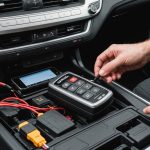Importance of Brake Fluid Maintenance
Brake fluid is essential for the safety and performance of any motorcycle, including the Honda Africa Twin. It acts as the medium that helps transfer the force from the rider’s foot or hand to the brakes, ensuring the motorcycle stops efficiently. Therefore, paying attention to brake fluid quality is non-negotiable. Poor quality fluid can lead to decreased effectiveness, increasing the stopping distance, which can be dangerous in emergencies.
Brake fluid quality impacts the bike’s braking efficiency directly. Over time, fluid can absorb moisture, leading to corrosion and possible brake system failure. This degradation reduces the fluid’s boiling point, compromising braking performance, especially under demanding conditions often experienced by motorcyclists. Hence, keeping the brake fluid in optimal condition is crucial for maintaining the safety features of the bike.
Also read : Top sticker kits to customize your motorcycle creatively
Regular maintenance intervals for changing brake fluid are highly important. Honda Africa Twin Maintenance guidelines suggest specific intervals for brake fluid changes, emphasising brake system care to prevent avoidable wear and tear. Not adhering to these intervals risks degradation of the system, ultimately compromising safety. Timely maintenance will sustain optimal performance, ensuring that riders can respond effectively in various riding scenarios.
Tools Required for Brake Fluid Inspection and Change
Embarking on DIY motorcycle maintenance, particularly when servicing your Honda Africa Twin, requires careful preparation with the right brake fluid change tools.
In the same genre : Mastering Your Suzuki GSX-R1000: Essential ABS Adjustment Settings Explained
Essential Tools List
Before starting, it is crucial to have the appropriate tools at your disposal. Begin with a brake bleed kit. This kit often includes hoses, fittings, and a catch bottle. Also, acquire a syringe or a vacuum pump, which aids in extracting old brake fluid efficiently. A pair of wrenches, ideally a combination of open-end and box-end, is necessary to handle the brake bleeders without causing any damage. Finally, use a funnel to ensure a clean pour of new fluid into the reservoir.
Recommended Brands and Specifications
When it comes to brands and specifications, some are particularly suitable for the Honda Africa Twin. Consider brands like Motive Products and Lisle, known for durable and efficient tools. Look for a bleed kit with a universal adapter to accommodate various brake reservoir shapes and sizes.
Optional Tools for Enhanced Maintenance
For those seeking an elevated level of care, invest in digital calipers to monitor brake pad wear closely. Additionally, a torque wrench ensures exact tightening of components, reducing wear and tear over time. Optional tools like a fluid extractor pump allow for a more seamless fluid replacement process. These enhancements can transform your maintenance into a truly seamless professional-level experience.
Step-by-Step Procedure for Inspecting Brake Fluid
Before beginning the brake fluid inspection on your Honda Africa Twin, it’s crucial to ensure safety and security.
Preparing the Motorcycle
Start by placing the motorcycle on a flat, stable surface. Use a centre stand if available, as it provides maximum stability. Ensure that the engine is off and the bike is cool to the touch to prevent any accidental burns. This preparation step is vital, as it helps in maintaining an accurate level check of the brake fluid.
Locating the Brake Fluid Reservoir
The brake fluid reservoir on the Honda Africa Twin Brake System is typically found near the handlebars or the foot brake lever, depending on whether you’re inspecting the front or rear brake. To access it, look for a small, often opaque reservoir usually marked with “DOT.” Once located, carefully remove any covers or protective elements that may obstruct access.
Visual and Physical Inspection Techniques
With the reservoir accessible, conduct a thorough visual inspection. Check for any discolouration or cloudiness in the fluid – this can indicate contamination. Optimal brake fluid should be clear or slightly amber.
For a physical inspection, gently tap the reservoir. Observe any unusual movement or resistance, indicative of problems within the brake system. Ensuring both visual and physical checks can help detect potential issues before they worsen.
Step-by-Step Procedure for Changing Brake Fluid
Changing brake fluid is a necessary maintenance task that ensures optimal braking performance. Here, we’ll explore Brake Fluid Replacement Steps, detailing how to safely replace your vehicle’s brake fluid.
Draining Old Brake Fluid
To begin, ensure your vehicle is parked on a level surface, with the engine off. Safety is paramount, so wear appropriate protective gear. Locate the brake fluid reservoir—usually close to the driver’s side—and use a siphon or turkey baster to remove as much old fluid as possible. Next, loosen the bleeder valves on each wheel using a wrench. Connect a clear tube to the valve, directing the other end into a container to collect the old brake fluid. This process requires patience, as it might take some time for the fluid to drain completely, preventing damage to brake components.
Filling with New Brake Fluid
Select a brake fluid type compatible with your vehicle—consult your owner’s manual for specifications. Open the new brake fluid and gradually pour it into the reservoir, topping it off as needed. Avoid mixing different fluid types, as this can damage the braking system.
Bleeding the Brake Lines
Ensure there’s ample new brake fluid before starting to bleed the lines. Begin with the wheel furthest from the brake fluid reservoir, typically the rear passenger side. Open the bleeder valve, and have an assistant press the brake pedal to expel air and old fluid. Continue until no air bubbles emerge, repeating for each wheel. This enhances braking performance, ensuring the system is air-free.
Safety Precautions During Brake Fluid Maintenance
Performing brake fluid maintenance on your motorcycle is a task that demands attention to safety precautions. Wearing personal protective equipment (PPE), such as gloves and goggles, is crucial. This not only protects your skin from brake fluid, which can be corrosive, but also ensures your safety against any unexpected splashes or leaks.
Brake fluid is known for its sensitivity to moisture, which can lead to reduced efficacy over time. Handle it carefully, avoiding spills that might affect paintwork or sensitive components of the motorcycle. Using a clean and dry container to collect old fluid can prevent accidental contamination of the workspace.
Additionally, ensure that the workspace is well-ventilated. Proper ventilation helps to disperse fumes, keeping the air safe to breathe. Make sure the motorcycle is securely levelled and supported on a flat surface to avoid any chances of it toppling over during the process.
Remember to keep all tools organized and at hand, to avoid inadvertently knocking over any brake fluid containers. By adhering to these motorcycle maintenance safety tips, you can perform brake fluid maintenance safely and effectively, minimizing risks and protecting both yourself and your motorcycle. Consider having a fire extinguisher nearby, just in case, to add an extra layer of safety.
Troubleshooting Common Issues
When dealing with brake fluid troubleshooting, it’s critical to identify and address potential issues to maintain optimal vehicle safety. Understanding and diagnosing common brake problems can save both time and cost in the long run.
Identifying Air in the Lines
One of the primary culprits of reduced brake performance is air trapped in the brake lines. This typically manifests as a spongy brake pedal feel and decreased braking efficiency. To rectify this issue, the brake system should be bled to remove air pockets. This process involves systematically opening brake bleeder screws and applying brake pressure to expel trapped air. Remember to refill the brake fluid reservoir to avoid introducing additional air.
Recognizing Contaminated Brake Fluid
Brake fluid contamination is another frequent problem. Indications include a darkened fluid colour or an oily residue in the reservoir. Contamination can drastically decrease braking effectiveness. Flushing and replacing the old fluid with fresh brake fluid is essential for ensuring reliable brake function. Consistently checking and replacing brake fluid can prevent dirt and moisture accumulation.
Resolving Brake Performance Issues
Post-maintenance, you might still encounter brake performance issues. Causes can range from improper installation to contaminated fluid or air in the lines. It is crucial to double-check all connections, and perform another system bleeding if necessary. Ensuring all components are correctly aligned and secure maintains braking efficiency.
Maintenance Tips for Optimal Brake Performance
Regular upkeep is essential for ensuring optimal brake performance in your Honda Africa Twin. One of the most crucial maintenance tasks is changing the brake fluid. It’s recommended to replace the brake fluid every two years or every 20,000 miles, whichever comes first. This schedule helps maintain the hydraulic efficiency of the brake system.
To keep the brakes performing well, it’s vital to monitor brake performance and fluid condition routinely. Observe any changes in braking efficiency—any spongy or less responsive brakes may indicate the need for fluid replacement or air in the system. Inspecting the brake fluid regularly for clarity is vital; it should be clear and free from contaminants. Cloudy or dark fluid means it’s time for a change.
For overall brake system health, adopt the following practices:
- Inspect brake lines, pads, and rotors for wear and tear.
- Ensure all brake components are securely fastened.
- Regularly clean brake calipers to prevent dirt buildup.
Proactively following these Honda Africa Twin care tips will significantly extend the lifespan of your brake system. By maintaining your brakes, you’ll ensure safety and performance on every road adventure.











